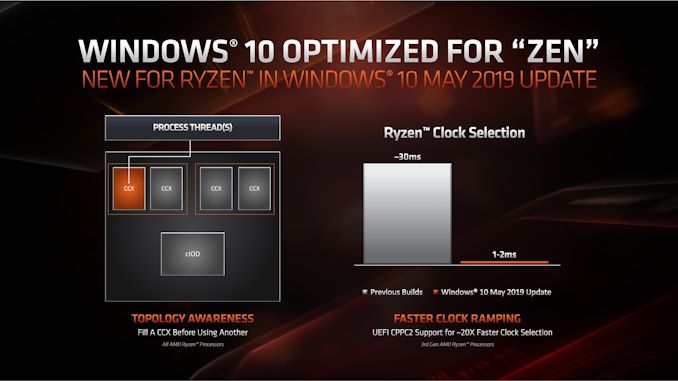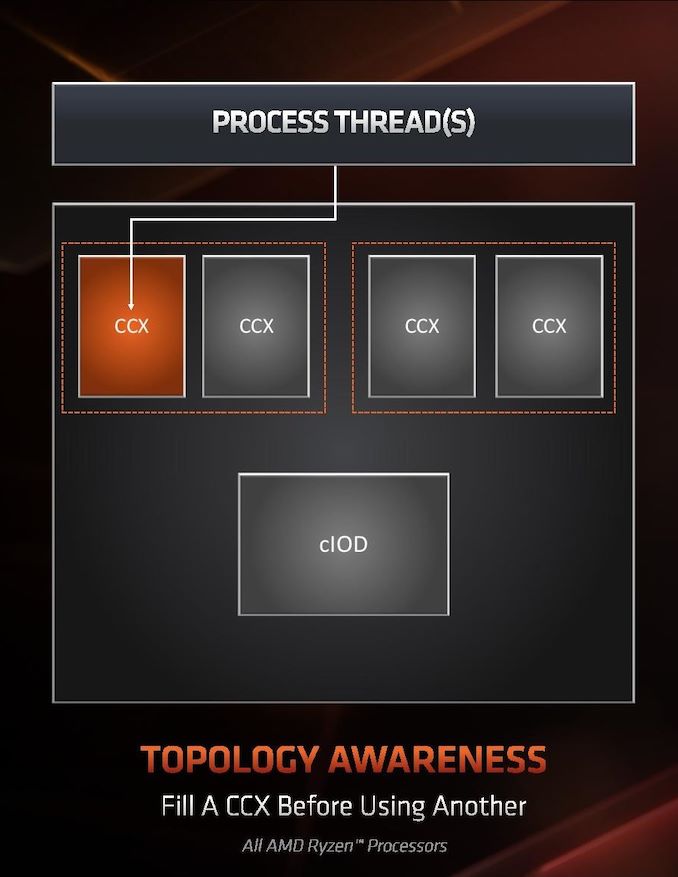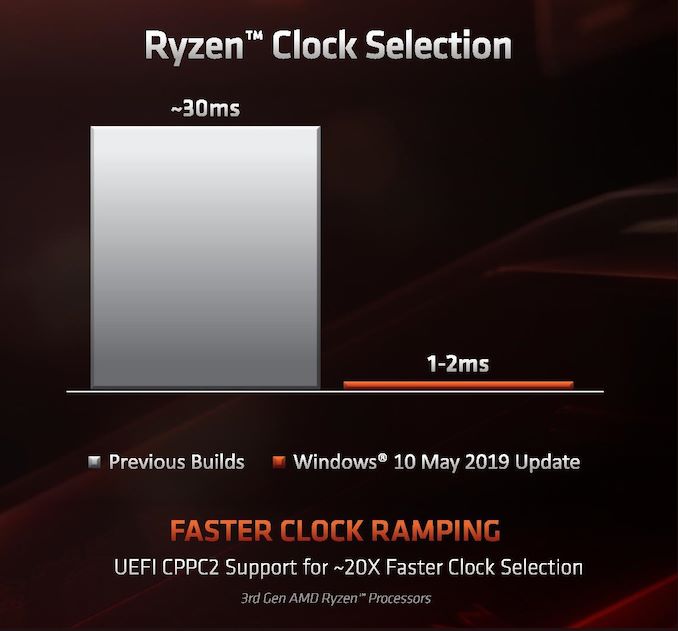AMD Zen 2 Microarchitecture Analysis: Ryzen 3000 and EPYC Rome
by Dr. Ian Cutress on June 10, 2019 7:22 PM EST- Posted in
- CPUs
- AMD
- Ryzen
- EPYC
- Infinity Fabric
- PCIe 4.0
- Zen 2
- Rome
- Ryzen 3000
- Ryzen 3rd Gen
Windows Optimizations
One of the key points that have been a pain in the side of non-Intel processors using Windows has been the optimizations and scheduler arrangements in the operating system. We’ve seen in the past how Windows has not been kind to non-Intel microarchitecture layouts, such as AMD’s previous module design in Bulldozer, the Qualcomm hybrid CPU strategy with Windows on Snapdragon, and more recently with multi-die arrangements on Threadripper that introduce different memory latency domains into consumer computing.
Obviously AMD has a close relationship with Microsoft when it comes down to identifying a non-regular core topology with a processor, and the two companies work towards ensuring that thread and memory assignments, absent of program driven direction, attempt to make the most out of the system. With the May 10th update to Windows, some additional features have been put in place to get the most out of the upcoming Zen 2 microarchitecture and Ryzen 3000 silicon layouts.
The optimizations come on two fronts, both of which are reasonably easy to explain.
Thread Grouping
The first is thread allocation. When a processor has different ‘groups’ of CPU cores, there are different ways in which threads are allocated, all of which have pros and cons. The two extremes for thread allocation come down to thread grouping and thread expansion.
Thread grouping is where as new threads are spawned, they will be allocated onto cores directly next to cores that already have threads. This keeps the threads close together, for thread-to-thread communication, however it can create regions of high power density, especially when there are many cores on the processor but only a couple are active.
Thread expansion is where cores are placed as far away from each other as possible. In AMD’s case, this would mean a second thread spawning on a different chiplet, or a different core complex/CCX, as far away as possible. This allows the CPU to maintain high performance by not having regions of high power density, typically providing the best turbo performance across multiple threads.
The danger of thread expansion is when a program spawns two threads that end up on different sides of the CPU. In Threadripper, this could even mean that the second thread was on a part of the CPU that had a long memory latency, causing an imbalance in the potential performance between the two threads, even though the cores those threads were on would have been at the higher turbo frequency.
Because of how modern software, and in particular video games, are now spawning multiple threads rather than relying on a single thread, and those threads need to talk to each other, AMD is moving from a hybrid thread expansion technique to a thread grouping technique. This means that one CCX will fill up with threads before another CCX is even accessed. AMD believes that despite the potential for high power density within a chiplet, while the other might be inactive, is still worth it for overall performance.
For Matisse, this should afford a nice improvement for limited thread scenarios, and on the face of the technology, gaming. It will be interesting to see how much of an affect this has on the upcoming EPYC Rome CPUs or future Threadripper designs. The single benchmark AMD provided in its explanation was Rocket League at 1080p Low, which reported a +15% frame rate gain.
Clock Ramping
For any of our users familiar with our Skylake microarchitecture deep dive, you may remember that Intel introduced a new feature called Speed Shift that enabled the processor to adjust between different P-states more freely, as well as ramping from idle to load very quickly – from 100 ms to 40ms in the first version in Skylake, then down to 15 ms with Kaby Lake. It did this by handing P-state control back from the OS to the processor, which reacted based on instruction throughput and request. With Zen 2, AMD is now enabling the same feature.
AMD already has sufficiently more granularity in its frequency adjustments over Intel, allowing for 25 MHz differences rather than 100 MHz differences, however enabling a faster ramp-to-load frequency jump is going to help AMD when it comes to very burst-driven workloads, such as WebXPRT (Intel’s favorite for this sort of demonstration). According to AMD, the way that this has been implemented with Zen 2 will require BIOS updates as well as moving to the Windows May 10th update, but it will reduce frequency ramping from ~30 milliseconds on Zen to ~1-2 milliseconds on Zen 2. It should be noted that this is much faster than the numbers Intel tends to provide.
The technical name for AMD’s implementation involves CPPC2, or Collaborative Power Performance Control 2, and AMD’s metrics state that this can increase burst workloads and also application loading. AMD cites a +6% performance gain in application launch times using PCMark10’s app launch sub-test.
Hardened Security for Zen 2
Another aspect to Zen 2 is AMD’s approach to heightened security requirements of modern processors. As has been reported, a good number of the recent array of side channel exploits do not affect AMD processors, primarily because of how AMD manages its TLB buffers that have always required additional security checks before most of this became an issue. Nonetheless, for the issues to which AMD is vulnerable, it has implemented a full hardware-based security platform for them.
The change here comes for the Speculative Store Bypass, known as Spectre v4, which AMD now has additional hardware to work in conjunction with the OS or virtual memory managers such as hypervisors in order to control. AMD doesn’t expect any performance change from these updates. Newer issues such as Foreshadow and Zombieload do not affect AMD processors.














216 Comments
View All Comments
GreenReaper - Tuesday, June 11, 2019 - link
A lot of progress has been made. Browsers are far more multithreaded than they once were - and as web pages become more complex, that benefit can scale. Similarly, databases and rendering can scale very well over certain operations.Said scaling tends to work best for the longest operations, because they can be split up into chunks without too much overhead. The overall impact should be that there are fewer long, noticeable delays. There isn't so much progress for things that are already pretty fast - or long sequences of operations that rely on one another. (However, precomputing and prefetching can help.)
stephenbrooks - Thursday, June 13, 2019 - link
I find it surprising how they add these smallish increases onto execution width, out of order buffers, register files etc. The IPC hasn't stopped increasing, it's just slow-ish. Maybe they're fighting power and latency in those part of the core so the 2x density from a node doesn't translate fully.Santoval - Tuesday, June 11, 2019 - link
Prices should drop when the competition with Intel becomes fiercer. I don't expect that anytime soon though.. It doesn't look like Intel will manage to release Ice Lake CPUs (except apparently the -U and -Y ones they announced) this year or at all.Their 10nm+ node is still having serious issues with clocks and thermals, and the yields are much lower than TSMC's 7nm (high performance) node. So "word on the street" is that they won't release Ice Lake CPUs for desktop at all. Id est that they'll can them and release instead Tiger Lake desktop CPUs fabbed with their fixed (??) 10nm++ node variant late next year (as in Q4 2020).
piroroadkill - Wednesday, June 12, 2019 - link
You're wrong. You get more performance than Intel at a lower price. In the case of the 3950X, it's significant. To sell them cheaper would devalue an incredible product, for no reason.Targon - Thursday, June 13, 2019 - link
Ryzen 7 2700X vs. Ryzen 7 3700X. Same price, better performance. Looking at the 3800X which is $399, look at the IPC+clock speed improvements. The 3900X will obviously come at a cost, because you are getting 50% more cores for that increased price. Single threaded though....at what point do you really focus on how fast or slow a single threaded program is running in this day and age where you run dozens of processes at the same time? If you are running dozens of single threaded programs, then performance will change based on how the OS scheduler assigns them to different CPU cores.Qasar - Thursday, June 13, 2019 - link
jjj" They give us around 20% ST gains (IPC+clocks) but at a cost. " that same thing could be said about intels cpus over the last few years... how much performance increase did they give us year over year ?? all while only giving is 4 cores for the mainstream... amd's prices are just fine.. intel is the one that should be dropping their prices, some as low as the $50 you say, but most, $500 or more
Tunnah - Monday, June 10, 2019 - link
I bet now Intel is just going to completely flood ads with the title "Intel beats AMD in pure FPS tests!", because they'll get 210fps where AMD gets 200. And some people will eat it up.I'm so excited for this upgrade. Replacing a 2700K with a 3800X, where I'll not only get a doubling of cores, but clock for clock I reckon it's a 40, 50% improvement there too.
My Civ games are gonna be so zoomy now..
xrror - Monday, June 10, 2019 - link
Intel will always beat AMD ......
...
(at a price point you don't give a f*ck about) (4 digits or more)
Are you a micro-trader hardwired into the BS Stock Exchange? You think $1000+ is too much for the fully enabled processor arch you want to overclock should cost you?
Sorry, Intel doesn't have the time of day for you after 2011, after Sandy Bridge took away the ability to overclock blessed "K" skus...
oh sure, there are others. IDT and Cyrix are dead but... let me introduce you to...
AMD
xrror - Monday, June 10, 2019 - link
This isn't aimed at you Tunnah. I meant it as humor.Read my comment like some exciting infocommercial, with ... (insert commanding infomercial voice here) hehe
Makaveli - Tuesday, June 11, 2019 - link
The 2700k and the 3800X are both 8C 16T designs.